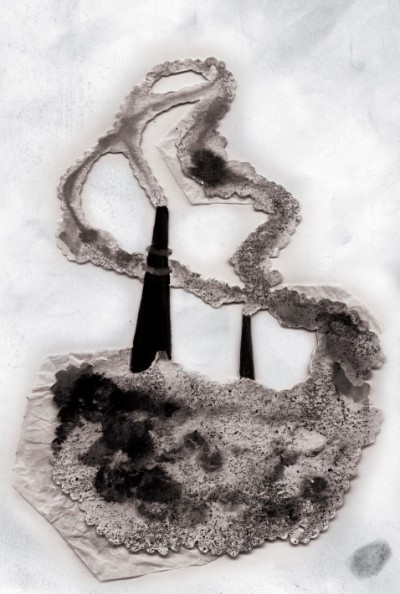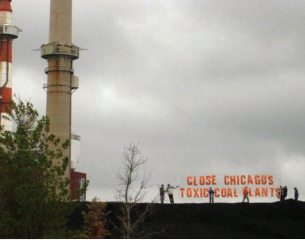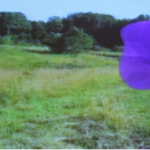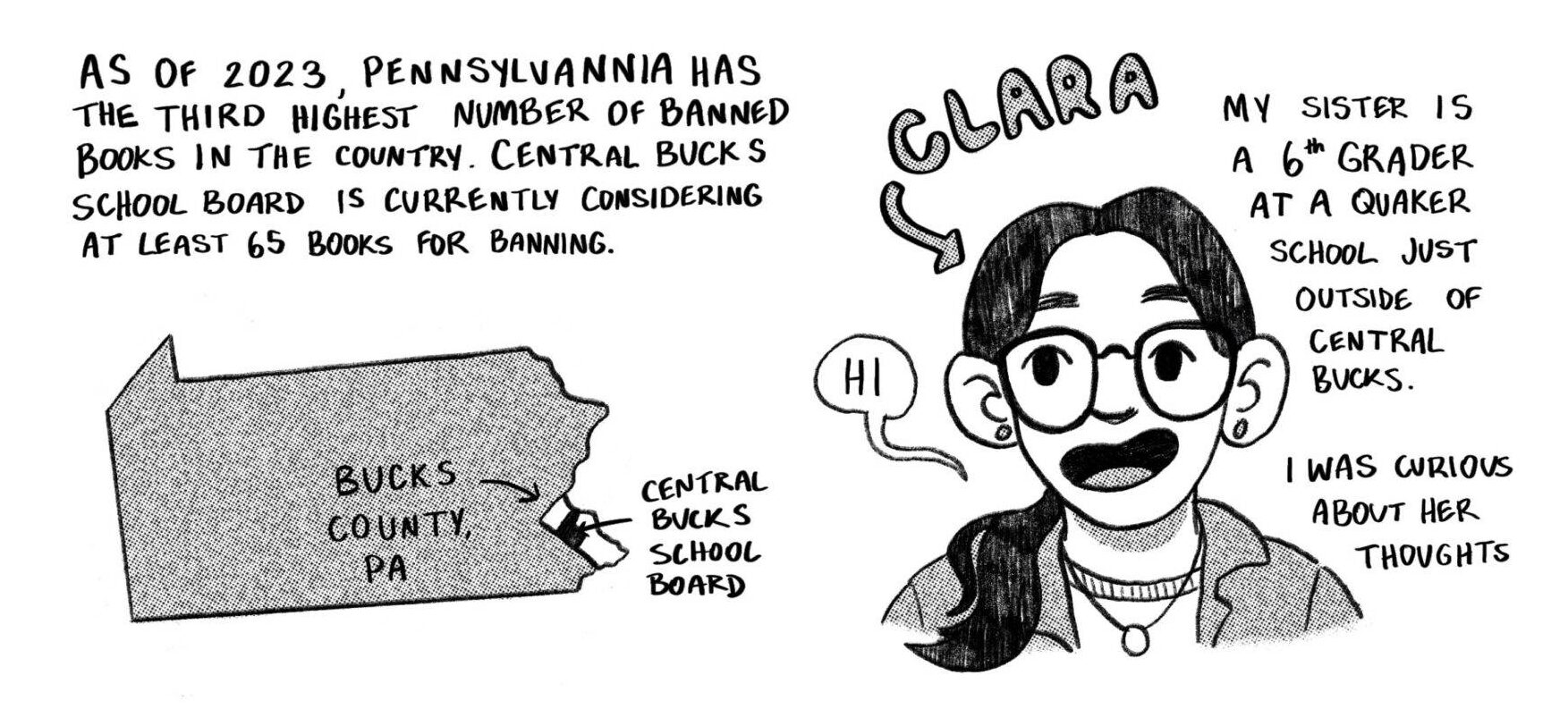
Illustration by Shannon Lee
“They knew fully well they would get arrested,” said Kelly Pope, SAIC student and leader of the Student Environmental Activism Committee (SEAC) on campus, recalling the day she witnessed her schoolmate and fellow SEAC leader Carlyn Crispell get arrested last April after climbing to the top of a mountain of coal at the Crawford Generating Plant with a huge banner that read “Close Chicago’s Toxic Coal Plants.”
“Crispell, who already graduated from SAIC, was charged with trespass on federal land, which is a misdemeanor. She stayed in jail for about twelve hours on the day she was arrested,” sayed Pope.
Chicago’s Fisk and Crawford coal plants, the first located in Pilsen and the second in Little Village, have been under attack for years by local and national environmental organizations such as the Little Village Environmental Justice Organization, the Pilsen Environmental Rights and Reform Organization (PERRO) and the Sierra Club, among others. Activists, including members of the SAIC SEAC, are demanding the city require the plants reduce their emissions or close down entirely. According to PERRO, the Crawford and Fisk coal-fired power plants are the two largest single sources of deadly particulate-forming air pollution in Chicago and contribute to the region’s violations of federal pollution health standards.
The operation of these two plants is linked to over 40 deaths, 550 emergency room visits, and 2,800 asthma attacks annually, according to researchers at the Harvard School of Public Health. These numbers are of special concern because Chicago is known as the asthma epicenter of the nation. In the city, the asthma hospitalization rate is nearly double the national average. In some Chicago neighborhoods, over 25% of children under the age of twelve suffer from asthma. Groups of young students in Pilsen, particularly from the Lozano Leadership Academy, have played a key role in the activist movement to protect the region’s air.
The United States Environmental Protection Agency’s (EPA) most recent data available (2003-04) states that the two plants combined emit 230 lbs. of mercury (which causes brain damage), 17,765 tons of sulfur dioxide and nitrogen oxide (which generates ozone and acid rain), and particulate matter that contributes to breathing problems, as well as 260,000 lbs. of soot.
Coal plants cause lead air pollution as well, and speaking specifically about Pilsen, the Illinois EPA’s found that “parts of Chicago’s Pilsen neighborhood do not meet the new national air quality standard for lead.” If the plants don’t meet the standards later this year, Illinois will be required to submit a plan by June 2013 to reduce lead emissions. The EPA explains that even at low levels, exposure to lead can impair a child’s IQ, learning capabilities and memory. Although airborne lead levels have dropped dramatically in the United States since the transition to unleaded gas, the latest reports indicate that stronger standards are necessary to protect children.

Photo by Kelly Pope
Midwest Generation, the company that owns the plant, disputes the allegations. “We don’t see a correlation between the allegations about our plants in relation to health,” said Susan Olavarria, Director of Communications and Government Affairs for Midwest Generation to F Newsmagazine. “Asthma, for example, has been rising across the country, while our pollution has been going down,” she affirmed. “In addition, the twelve monitors that the Illinois EPA use in the Cook County area to measure particles in the air and where they come from, have indicated that our plants account for less than half of one percent of the pollution in the air. The biggest pollutant cause is vehicles.” She concluded the interview by clearing up her point. “Don’t get me wrong; I’m not saying that our plants aren’t contributing to what’s in the air. I’m just saying that it’s not as much as people are claiming, and that we are continuing to improve our facilities.”
A website for the Fisk and Crawford plants reports that the particulate matter emissions coming from the plants have been reduced 25% in the past ten years.
Built roughly a century ago, the two structures were once symbols of progress and modernity; environmentalists now call them dysfunctional relics. Under the 1977 Clean Air act, the plants are exempt from meeting the same pollution limits as new facilities. At the time it was assumed they would close down in the near future but the plants continue to operate today. A 2010 study by the Environmental Law & Policy Center, a Midwest environmental advocacy organization, determined that the plants are costing the public $127 million (in 2010 dollars) per year in health and environmental related damages.
Peter Gray, a member of the Environmental Law & Policy Center, has been involved for years in efforts to reduce pollution from the Fisk and Crawford Plants. “In 2009 we were one of the groups to file a lawsuit against Midwest Generation for exceeding their emission limits. We tested this by the opacity, or how little light we could see coming through the smoke, and they were way over their limit. That suit is still in process today.”
“Carbon dioxide and particulate matter are the two most dangerous things to come out of the smoke stacks, and what is causing asthma, heart attacks and deaths in Chicago,” Peter Gray said. The Clean Air Task Force, a non-profit organization that primarily uses research to advocate for environmental change, released a 2010 study that found that the coal plants in Chicago cause 42 premature deaths annually.
The Environmental Law and Policy Center* is currently working with the Chicago Clean Power Coalition to pass the Clean Power Ordinance in the City Council. The Ordinance would require the two plants restrict their emissions. Currently backed by 49th Ward Alderman Joe Moore and 25th Ward Alderman Danny Solis, the ordinance is similar to a 2002 version that was backed by Alderman Ed Burke, which died in committee. Moore and Solis need 26 affirmative votes to pass.
Solis’ ward encompasses much of the area most affected by the power plants. Until March 2011, he had declined to support the ordinance, critics said because he had received generous donations from Midwest Generation. After months of pressure, Solis agreed to become a co-sponsor of the ordinance. At the July 28 City Council hearing during which the ordinance was introduced, Solis said, “There is no doubt that these coal power plants need to be cleaned up immediately to protect the fundamental health and safety of our communities. I am proud to have played a leading role in sponsoring the Clean Power Ordinance.”
Midwest Generation opposes the Clean Air Ordinance. “Not because we don’t want clean air, but because the ordinance would force us to shut our doors,” explained Olavarria. “Not only would we not be able to comply, but also no coal plant would be able to. The only way we would be able to comply would be to shut down and reconstruct as a Natural Gas Plant.”
SAIC student Kelly Pope was at the April 21 City Council hearing about the ordinance, at which the bill didn’t reach a vote. She was barely able to get a seat. “Midwest Generation packed the room full of workers hours before the hearing started, and gave them all candy bars,” says Pope. “Most of the workers didn’t even work in Chicago, either. They would chant, ‘Save our jobs, save our jobs,’ and we would chant, ‘Save our lives, save our lives.’”
SAIC’s SEAC student group has worked on zines about the plants, helped build a “coal baron” puppet for actions, and mud-stenciled messages reading, “We deserve to breathe clean air! Close Chicago’s coal plants!” around Pilsen. Activists remain hopeful, as at the most recent hearing on July 28 the ordinance was supported by the majority of the City Council and Chicago Mayor Rahm Emanuel has said Midwest Generation should either install equipment to dramatically reduce pollution or convert to natural gas.
* In the print edition of this article (October 2011) The Environmental Law and Policy Center was erroneously listed here as the Environmental Law and Protection Agency.






















Time for the coal to go away, once and for all http://kallipygotera.com/resistance/ particulate-breeze-dangerous-as-ever/ for a song dedicated to those courageously battling. Best regards, Hal.